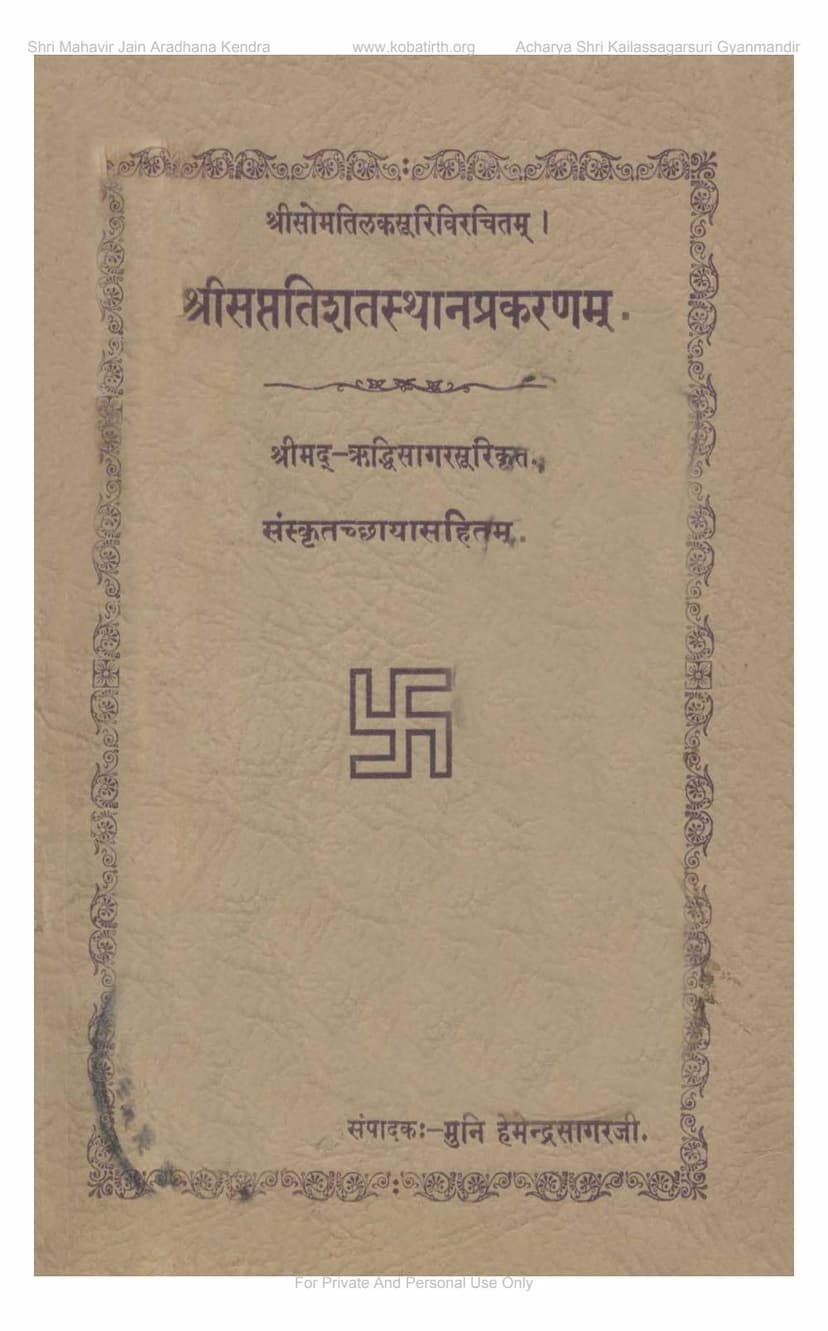Saptatishat Sthana Prakaranam Part 2
Added to library: September 2, 2025

Summary
Here's a comprehensive summary of the Jain text "Saptatishat Sthana Prakaranam Part 2," authored by Ruddhisagar and published by Buddhisagarsuri Jain Gyanmandir:
Title: Saptatishat Sthana Prakaranam Part 2 Author: Ruddhisagar Original Work: Composed by Somatilak Suri Sanskrit Commentary/Translation: By Shrimad Riddhisagar Suri Editor: Muni Hemendrasagarji Publisher: Shreemad Buddhisagarsuri Jain Gyanmandir, Vijapur (Gujarat)
Overview:
"Saptatishat Sthana Prakaranam" translates to "Treatise on Seventy-Seven Stages/Positions." This work, as indicated by the title and the introductory pages, is a commentary or elaboration on an original work by Acharya Somatilak Suri. The Sanskrit translation and commentary are attributed to Acharya Riddhisagar Suri, and the text has been researched and revised by Muni Hemendrasagarji. The text is part of the "Shree Buddhisagarsuri Jain Granthmala No. 2."
The core of the text is dedicated to detailing "Saptatishat Sthana" (77 positions or stages) related to Tirthankaras and their lives. It systematically enumerates and describes various aspects and stages in the existence of Tirthankaras, from their pre-birth to their liberation. The text aims to provide a structured understanding of these significant aspects for the study and practice of Jainism.
Key Content Areas and Themes:
The text systematically lists and explains numerous points, broadly categorized as follows:
-
Tirthankara Life Stages (Kalyanakas): The work begins by stating its intention to describe the sequence of the five auspicious events (Panch Kalyanaka) of Tirthankaras, starting with their departure from the celestial realm (Chyavana) and continuing through conception, birth, renunciation, attainment of omniscience, and liberation (Moksha).
-
Pre-existence and Ancestry: A significant portion of the text is dedicated to detailing the previous lives (Purva Bhava) of Tirthankaras. This includes:
- Previous Births and Positions: Listing various stages, realms, and life circumstances in previous births (e.g., life in different continents, cities, celestial realms, hellish realms, etc.).
- Family and Lineage: Information about the parents, lineage (Gotra), and royal families of the Tirthankaras.
- Names and Symbols: Details about the names, specific characteristics, and identifying symbols (Lanchana) of Tirthankaras.
- Physical Attributes: Descriptions of their bodily features, height, strength, and other physical characteristics.
- Cosmological Details: Information related to celestial bodies, astrological positions (Nakshatra, Rashi), and the structure of the universe as it pertains to the lives of Tirthankaras.
-
Specific Stages and Incarnations: The text meticulously lists out the 77 (or in some cases, around that number) "sthanas" or stages, which cover a wide range of specific events, states, and entities associated with Tirthankaras and Jain cosmology:
- Life Events: Birth, renunciation, attainment of omniscience (Kevala Jnana), and liberation (Moksha).
- Cosmic Elements: Continents, regions, mountains, rivers, cities, forests, trees.
- Celestial and Infernal Beings: Various classes of celestial beings (Devas), their realms, lifespans, and the beings in hellish realms.
- Spiritual States and Practices: Types of knowledge (Manojnana, Avadhi, Manaparyaya, Kevala), the state of being a layman (Grihi), ascetics (Muni, Sanyati), mendicants, and the stages of spiritual progress.
- Vows and Observances: Details about vows (Vrata), penances (Tapa), and their associated practices.
- Important Figures: Mention of various kings, celestial beings, disciples (Ganadharas), important lay followers (Shravakas, Shravikas), and divine attendants.
-
Detailed Enumeration of Tirthankaras: The text provides a systematic listing of all 24 Tirthankaras, along with their respective life details, previous births, parents, symbols, and key events. This is a central theme, presenting a comprehensive genealogical and biographical account within the Jain framework.
-
Specific Numerical and Categorical Information: The text often presents information in numerical lists, categorizing various aspects. For instance, it details the lifespan of Tirthankaras in different previous births, the number of disciples, the types of omens, and the durations of different stages.
-
Ethical and Spiritual Principles: Interwoven with the factual and cosmological details are references to Jain ethical principles, such as the importance of renunciation, the nature of right faith (Samyak Darshan), right knowledge (Samyak Jnana), and right conduct (Samyak Charitra). The latter part of the text, particularly the "Atma Bhavna" section, offers philosophical reflections and guidance on spiritual practice, emphasizing principles like non-attachment, equanimity, and the pursuit of liberation.
-
Commentary and Revision: The Sanskrit commentary by Riddhisagar Suri aims to clarify and explain the original Prakrit or Apabhramsa text of Somatilak Suri. Muni Hemendrasagarji's role as editor signifies a scholarly effort to research, revise, and present the text in an accessible manner.
Significance and Purpose:
- Scholarly Resource: This work serves as a valuable reference for scholars and students of Jainism, providing detailed information about the lives and spiritual journeys of Tirthankaras, which are central to Jain doctrine.
- Devotional and Inspirational: By detailing the exalted lives of Tirthankaras, the text also serves a devotional purpose, inspiring adherents to follow the path of renunciation, spiritual discipline, and ethical conduct.
- Understanding Jain Cosmology: The text offers insights into the structured universe and the cyclical nature of time and existence as understood in Jainism, particularly concerning the dissemination of spiritual teachings by Tirthankaras.
- Preservation of Knowledge: The publication of such ancient texts by institutions like the Buddhisagarsuri Jain Gyanmandir is crucial for preserving and disseminating Jain knowledge across generations.
In essence, "Saptatishat Sthana Prakaranam Part 2" is a detailed and systematic compendium of the significant stages and events in the lives of Tirthankaras, presented through the commentary of Acharya Riddhisagar Suri on the work of Acharya Somatilak Suri, thereby offering a deep dive into the foundational narratives and cosmological framework of Jainism.